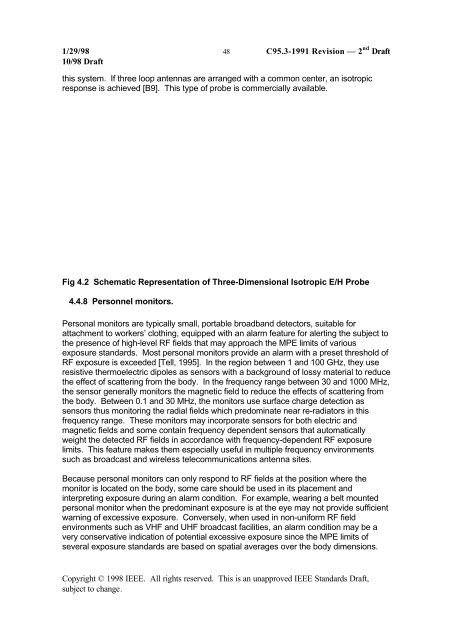DRAFT Recommended Practice for Measurements and ...
DRAFT Recommended Practice for Measurements and ...
DRAFT Recommended Practice for Measurements and ...
Create successful ePaper yourself
Turn your PDF publications into a flip-book with our unique Google optimized e-Paper software.
1/29/98 48 C95.3-1991 Revision — 2 nd Draft<br />
10/98 Draft<br />
this system. If three loop antennas are arranged with a common center, an isotropic<br />
response is achieved [B9]. This type of probe is commercially available.<br />
Fig 4.2 Schematic Representation of Three-Dimensional Isotropic E/H Probe<br />
4.4.8 Personnel monitors.<br />
Personal monitors are typically small, portable broadb<strong>and</strong> detectors, suitable <strong>for</strong><br />
attachment to workers’ clothing, equipped with an alarm feature <strong>for</strong> alerting the subject to<br />
the presence of high-level RF fields that may approach the MPE limits of various<br />
exposure st<strong>and</strong>ards. Most personal monitors provide an alarm with a preset threshold of<br />
RF exposure is exceeded [Tell, 1995]. In the region between 1 <strong>and</strong> 100 GHz, they use<br />
resistive thermoelectric dipoles as sensors with a background of lossy material to reduce<br />
the effect of scattering from the body. In the frequency range between 30 <strong>and</strong> 1000 MHz,<br />
the sensor generally monitors the magnetic field to reduce the effects of scattering from<br />
the body. Between 0.1 <strong>and</strong> 30 MHz, the monitors use surface charge detection as<br />
sensors thus monitoring the radial fields which predominate near re-radiators in this<br />
frequency range. These monitors may incorporate sensors <strong>for</strong> both electric <strong>and</strong><br />
magnetic fields <strong>and</strong> some contain frequency dependent sensors that automatically<br />
weight the detected RF fields in accordance with frequency-dependent RF exposure<br />
limits. This feature makes them especially useful in multiple frequency environments<br />
such as broadcast <strong>and</strong> wireless telecommunications antenna sites.<br />
Because personal monitors can only respond to RF fields at the position where the<br />
monitor is located on the body, some care should be used in its placement <strong>and</strong><br />
interpreting exposure during an alarm condition. For example, wearing a belt mounted<br />
personal monitor when the predominant exposure is at the eye may not provide sufficient<br />
warning of excessive exposure. Conversely, when used in non-uni<strong>for</strong>m RF field<br />
environments such as VHF <strong>and</strong> UHF broadcast facilities, an alarm condition may be a<br />
very conservative indication of potential excessive exposure since the MPE limits of<br />
several exposure st<strong>and</strong>ards are based on spatial averages over the body dimensions.<br />
Copyright © 1998 IEEE. All rights reserved. This is an unapproved IEEE St<strong>and</strong>ards Draft,<br />
subject to change.
















